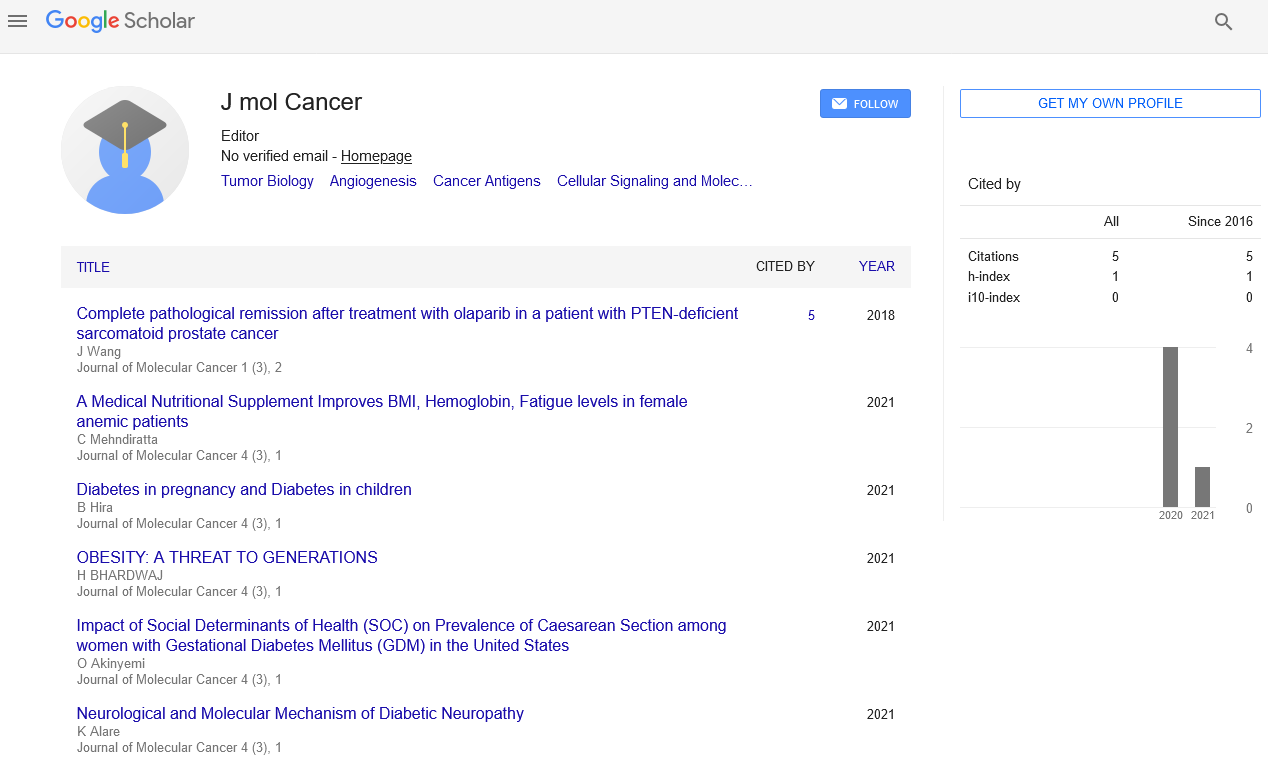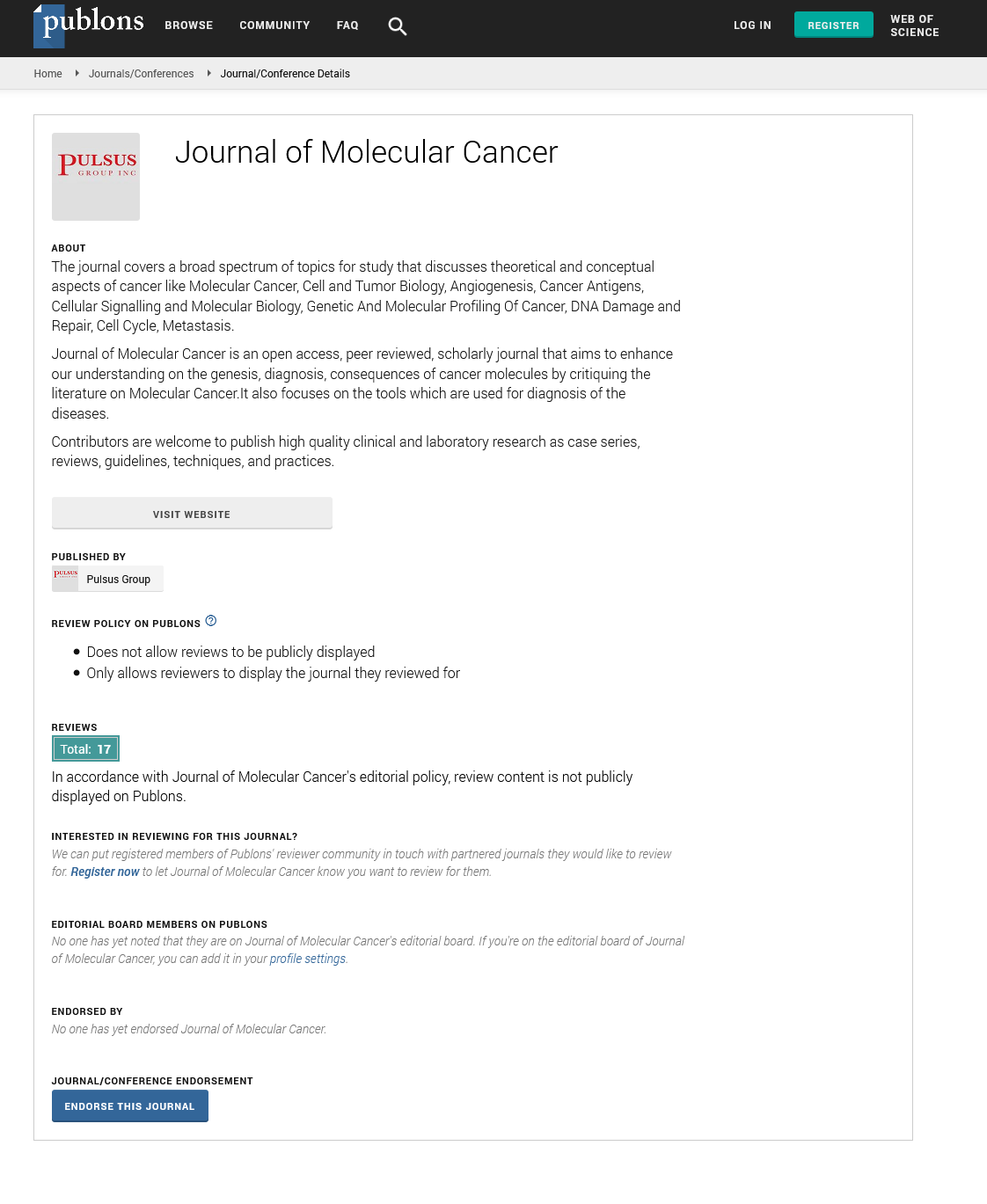The clinical fix for treating NSCLC
Received: 10-Jan-2022, Manuscript No. PULJMC-22-4270; Editor assigned: 12-Jan-2022, Pre QC No. PULJMC-22-4270(PQ); Accepted Date: Jan 12, 2022; Reviewed: 17-Jan-2022 QC No. PULJMC-22-4270; Revised: 14-Jan-2022, Manuscript No. PULJMC-22-4270(R); Published: 21-Jan-2022, DOI: doi:10.37532/puljmc.22.5.1.1
Citation: Janssens E. The clinical fix for treating NSCLC. J Mol Cancer. 2022;5(1):1.
This open-access article is distributed under the terms of the Creative Commons Attribution Non-Commercial License (CC BY-NC) (http://creativecommons.org/licenses/by-nc/4.0/), which permits reuse, distribution and reproduction of the article, provided that the original work is properly cited and the reuse is restricted to noncommercial purposes. For commercial reuse, contact reprints@pulsus.com
Abstract
Non-Small Cell Lung Cancer (NSCLC) is an exceptionally dangerous cancer, with a critical mortality and dreariness. With the improvement of growth immunotherapy, Illusory Antigen Receptor T Cells (CART) gets progressively consideration and accomplishes unmistakable commitments in the treatment of hematologic malignancies. CART treatment for NSCLC continues gradually and further explores should be researched. In our review, we performed bioinformatics examination to assess the critical job of CD147 in NSCLC. The articulation level of CD147 was distinguished in human NSCLC cell lines and NSCLC tissues. Cell cytotoxicity and cytokine discharge were performed to assess the viability of CD147-CART. We additionally built Cell-Inferred Xenograft (CDX) model and Patient-Determined Xenograft (PDX) model, which was utilized to additionally research the wellbeing and adequacy of CD147-CART in vivo. Our perceptions show that CD147 is a particular cancer antigen of NSCLC and assumes a fundamental part in NSCLC movement, which can be utilized as an objective for CART treatment in NSCLC. Significantly, CD147-CART cells have solid enemy of growth movement against NSCLC cells in vivo in both CDX and PDX models and no antagonistic incidental effects. Our discoveries show that CD147-CART immunotherapy for NSCLC is protected and successful, which is an ideal and promising clinical fix for treating NSCLC.
Key Words
Non-small cell lung cancer; Illusory antigen receptor T cells; Cell-inferred xenograft; Patient-determined xenograft
Introduction
The rate of disease has been expanding steadily, which compromises human wellbeing truly. Information from the World Health Organization (WHO) shows that the mortality (18%) and bleakness (11.4%) paces of cellular breakdown in the lungs possesses the first or second situation in quite a while around the world. NSCLC represents roughly 85% of cellular breakdown in the lungs, Lung Adenocarcinoma (LUAD) and Lung Squamous Cell Carcinoma (LUSC) fundamentally included. Subsequently, it is important to foster novel medicines for NSCLC patients to further develop endurance and personal satisfaction. With the advancement of growth immunology, immunotherapy gets progressively consideration and accomplishes conspicuous commitments in disease treatment, including Cytotoxic T-Lymphocyte Antigen-4 (CTLA-4) inhibitors, customized passing 1 (PD-1) inhibitors, CART, dendritic cell antibody, and cytokine-prompted executioner cells. Presently, most growth related antigens are utilized as focuses for CART treatment in NSCLC patients, including EGFR, MSLN, MUC1, and PSCA, which adds to on track/off-cancer and cell harmfulness. The special specialized benefits of CART cell treatment, including no limit of MHC antigen show, short planning time in vitro and resistant memory potential, are normal and wanted in the field of strong cancer treatment. In this manner, the further examination on CART cells for NSCLC treatment is earnestly expected to beat deterrents. In our review, we observed that CD147 was a particular cancer antigen of NSCLC and assumed a fundamental part in NSCLC movement, which could be utilized as an objective for CART treatment in NSCLC. In vitro and in vivo tests showed that CD147-CART cells displayed a solid enemy of cancer action against NSCLC growth cells. Our discoveries show that CD147-CART immunotherapy for NSCLC is protected and compelling, which gives a promising objective and drives the clinical advancement for NSCLC treatment.
Result
CD147 is accounted for to be a significant cancer related antigen in various growths. To additionally investigate the job of CD147 in NSCLC movement, the information of LUAD and LUSC got from TCGA data set was performed by bioinformatics examination. Head Part Examination (PCA) showed a different pattern in cancer tests from the high and low CD147 bunches in both LUAD and LUSC tissues. This outcome demonstrated that there existed two different quality articulation designs in the high and low CD147 tests, which was firmly connected with CD147 articulation. In LUAD, an aggregate of 3571 qualities was distinguished as DEGs between the high and low CD147 gatherings, including 707 up-controlled qualities and 2864 down-managed qualities in high CD147 bunch; in LUSC, 3250 qualities were screened as DEGs, including 742 up-directed qualities and 2508 down-managed qualities in high CD147 bunch. Then, at that point, the best 50 DEGs were chosen and shown in heat map. GO improvement investigation and KEGG pathway examination uncovered these DEGs were mostly connected with growth invulnerable reaction, cancer cell expansion, and cancer cell digestion. Clock is a thorough internet based asset for precise investigation of invulnerable invades across assorted disease types utilizing RNA-Seq articulation profiling information. The invasion of CD8+ T cells was evaluated by TIMER on NSCLC test information and the outcomes signified that the penetration of CD8+ T cells was adversely connected with CD147 articulation in NSCLC. GEPIA is a recently evolved intelligent web server for examining RNA-Seq articulation information of growths and typical examples from TCGA and GTEx projects, which gives differential articulation investigation and patient endurance examination. Operating system investigation from GEPIA showed that high CD147 articulation anticipated a helpless visualization in NSCLC.






